Customer Support Key Performance Indicators Defined with Examples
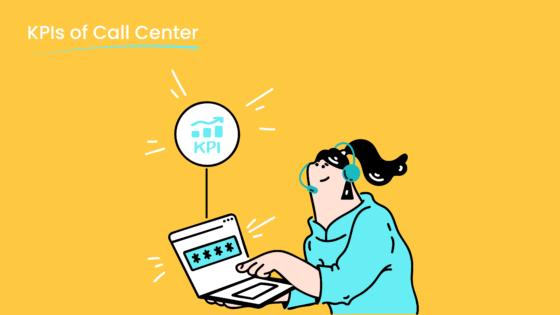
Customer support key performance indicators measure how well a team meets customer needs. Tracking these KPIs helps support teams boost efficiency, raise customer satisfaction, and solve problems faster. Sobot call center solutions use AI tools and real-time data to improve support results. Sobot AI increases first-contact resolution and reduces average handle time, with some support teams seeing a 54% jump in first-contact resolution. Actionable insights from key performance indicators drive training, process upgrades, and smarter support decisions. Every organization can use these KPIs to create better support experiences and stronger customer loyalty.
Customer Support Key Performance Indicators
Definition
Customer support key performance indicators are measurable values that show how well a customer service team meets its goals. These key performance indicators help teams track progress and improve their work. Some of the most common customer service key performance indicators include:
- Customer Satisfaction Score (CSAT): Measures how happy customers feel after an interaction.
- Net Promoter Score (NPS): Shows how likely customers are to recommend the company.
- Customer Effort Score (CES): Tells how easy it is for customers to get help.
- First Contact Resolution (FCR): Tracks if the team solves the problem on the first try.
- Average Handle Time (AHT): Measures how long each support interaction takes.
- Time to Resolution (TTR): Shows how quickly the team solves issues.
- Customer Retention Rate: Tracks how many customers stay with the company.
- Ticket Volume by Channel: Counts how many requests come from each support channel.
These customer service key performance indicators give a clear picture of team performance. They help managers see where the team does well and where they need to improve. Customer service metrics like these are easy to measure and share with the team.
Importance
Tracking customer support key performance indicators is important for every business. These key performance indicators help companies make smart decisions based on real data. When teams review their kpi results, they can spot trends, fix problems, and set better goals. For example, if the average handle time is too high, the team can look for ways to work faster. If the customer satisfaction score drops, leaders can find out why and make changes.
Studies show that 27% of Americans say poor customer service is their biggest frustration. By using kpi data, companies can improve customer service and keep customers happy. Key performance indicators also help teams stay focused on what matters most. They show if the team meets service standards and help guide training and process changes. Over time, tracking these kpi leads to better customer loyalty and business growth.
Tip: Regularly review and update your customer support key performance indicators to match changing customer needs and business goals.
Sobot’s Role
Sobot helps businesses measure and improve customer support key performance indicators with advanced technology. The Sobot platform uses AI to automate tasks, assist agents, and provide real-time analytics. Sobot’s unified workspace brings together all customer service channels, making it easy to track key performance indicators like first contact resolution, customer satisfaction, and average handle time.
Sobot’s AI Insight module gives instant reports on kpi such as resolution rate and escalation rate. The platform also helps teams spot knowledge gaps and improve support quality. With features like AI Copilot, Sobot boosts agent efficiency by summarizing conversations and filling in ticket details. This means teams can respond faster and solve more problems on the first try.
Sobot’s solutions support continuous improvement. Teams can use the data from key performance indicators to make better decisions and deliver top customer service. By using Sobot, companies can keep their customer service metrics high and meet their business goals.
| KPI Name | Description & Use Case | Example Benchmark / Use |
|---|---|---|
| Customer Satisfaction Score (CSAT) | Measures customer happiness after support interactions. | 2-5% annual improvement goal |
| Net Promoter Score (NPS) | Shows customer loyalty and likelihood to recommend. | Scores above 60-70 are strong |
| First Contact Resolution (FCR) | Tracks if issues are solved on the first try. | High FCR saves costs and boosts satisfaction |
| Average Handle Time (AHT) | Measures time spent per support interaction. | Lower AHT with high CSAT is ideal |
| Customer Effort Score (CES) | Shows how easy it is for customers to get help. | Used to find and fix friction points |
For more details on Sobot’s solutions, visit Sobot’s official website.
Essential Customer Service KPIs

Customer service teams rely on key performance indicators to measure and improve their work. These customer service KPIs help leaders understand how well their teams meet customer needs. By tracking the right KPIs, companies can boost efficiency, reduce costs, and create better customer experiences. Sobot’s Voice/Call Center provides advanced tools to monitor and improve these metrics in real time. Below are the most essential customer service key performance indicators every support team should track.
First Contact Resolution
First contact resolution (FCR) measures the percentage of customer issues solved during the first interaction, without the need for follow-up. This KPI shows how well agents understand problems and provide solutions right away. High FCR rates mean customers get answers quickly, which leads to higher satisfaction and loyalty.
| Industry / Call Type | Average First Contact Resolution (FCR) Rate |
|---|---|
| Overall Industry Average | ~70% |
| Retail | 78% |
| Insurance | 76% |
| Energy | 71% |
| Financial | 71% |
| Call Center | 71% |
| Technology Support | 65% |
| Inquiries (Call Type) | 74% |
| Account Maintenance | 73% |
| Orders | 72% |
| Billing | 71% |
| Claims | 59% |
| Complaints | 47% |
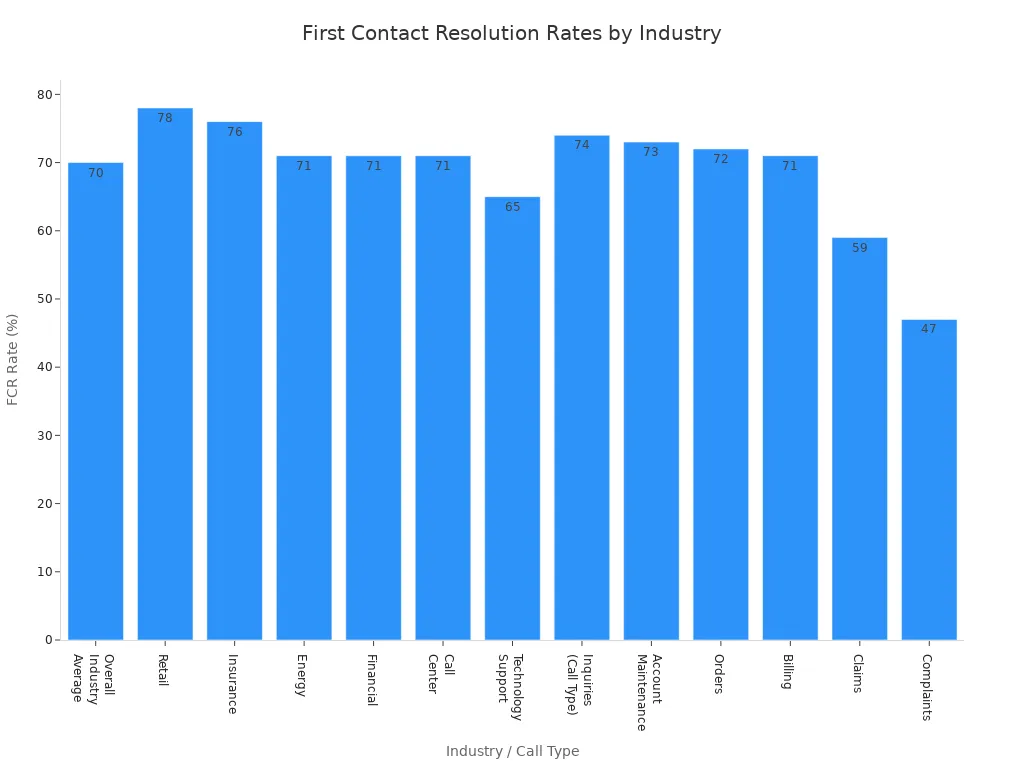
Most industries aim for an FCR rate around 70%. Retail and insurance sectors often perform better, reaching up to 78%. Only about 5% of companies achieve a world-class FCR rate of 80% or higher. Higher FCR rates link directly to improved customer satisfaction, loyalty, and lower operational costs. When support teams resolve issues on the first try, customers do not need to call back, which saves time and resources.
High FCR rates improve customer satisfaction by resolving issues promptly and reducing frustration. They also lower operational costs by reducing repeat contacts and freeing agents to handle new issues.
Sobot’s Voice/Call Center uses AI-powered routing and real-time analytics to help agents solve problems faster. The unified workspace gives agents access to customer history and knowledge bases, making it easier to resolve issues during the first contact. Sobot’s system tracks FCR rates and provides actionable insights, so managers can identify training needs and process gaps.
Time to Resolution
Time to resolution (TTR) measures how long it takes for a support team to solve a customer issue from the moment it is reported until it is fully resolved. This KPI is critical for understanding how quickly customers get the help they need. A lower average resolution time means customers spend less time waiting, which leads to higher satisfaction.
The average time to resolution for customer support inquiries in leading industries is about 8.5 minutes or less. However, this number changes based on the type of issue, the industry, and the support channel. Simple problems like password resets may be solved in minutes, while complex technical issues can take days. E-commerce and software companies usually aim for faster resolution times than financial services or healthcare.
Several factors affect time to resolution:
- Issue complexity: More difficult problems take longer to solve.
- Query volume: High volumes can increase average resolution time.
- Agent training: Well-trained agents resolve issues faster.
- Support tools: Advanced tools like Sobot’s Voice/Call Center speed up the process.
- Internal workflows: Efficient processes reduce delays.
Sobot’s Voice/Call Center uses AI-driven automation to reduce first response time and time to resolution. For example, Agilent improved its customer service efficiency sixfold by using Sobot’s chatbot to handle routine questions, letting human agents focus on complex cases. OPPO achieved an 83% resolution rate and 94% positive feedback after implementing Sobot’s chatbot. Sobot’s system also supports multilingual interactions and integrates with CRM systems, helping teams resolve issues quickly across the globe.
AI-powered tools can reduce resolution times by up to 50%. Real-time prompts and automated workflows help agents respond faster and more accurately.
Customer Satisfaction Score
Customer satisfaction score (CSAT) is one of the most important key performance indicators for customer service. CSAT measures how happy customers feel after a support interaction. Teams usually collect this score through a short survey after each case, asking customers to rate their experience.
CSAT scores range from 0% to 100%. Scores below 50% show major dissatisfaction. In industries like SaaS and e-commerce, a CSAT score around 80% is a strong benchmark for high-performing teams. Top teams can reach up to 95%, but a perfect score is rare.
| Industry | Average CSAT Score (%) |
|---|---|
| Retail | ~78 |
| Software | ~79 |
| Telecommunications | ~65 |
| Healthcare | ~76 |
| Hospitality | ~85 |
| Financial Services | ~75 |
| E-commerce | ~78 |
| Automotive | ~80 |
| Utilities | ~72 |
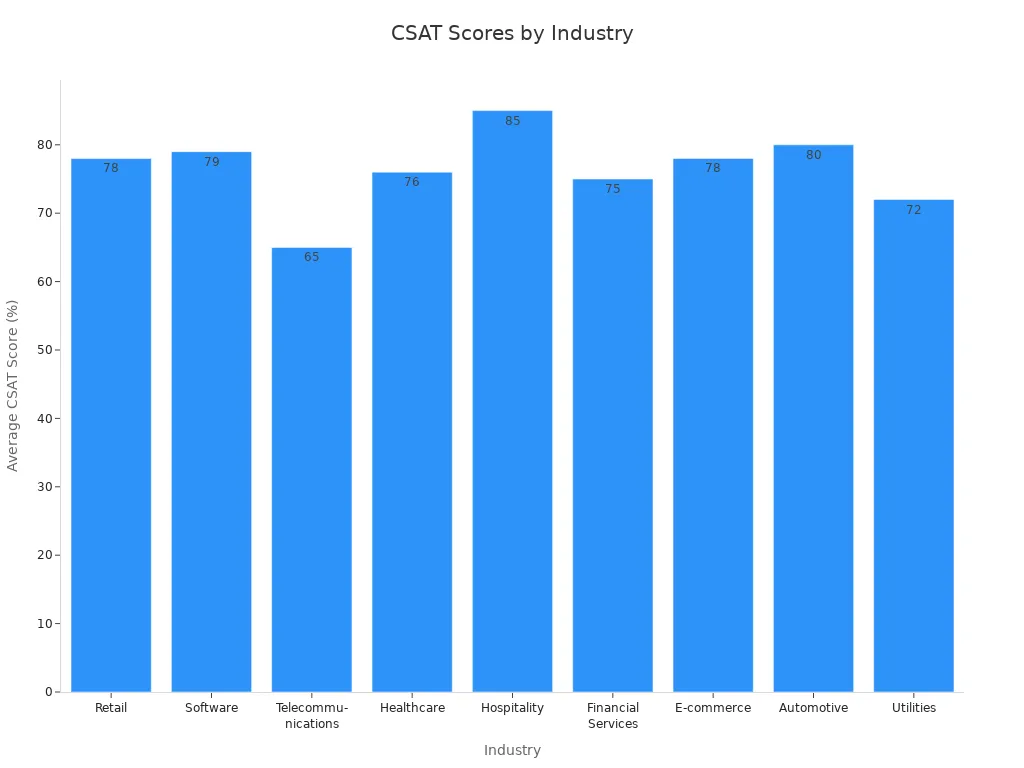
Sobot’s Voice/Call Center helps increase customer satisfaction scores by using AI-powered sentiment analysis and automation. The system provides 24/7 support, automates repetitive tasks, and gives agents real-time feedback on customer emotions. This allows agents to respond with empathy and solve problems faster. Companies using Sobot’s AI tools have seen productivity gains of up to 400% and significant improvements in customer satisfaction and loyalty.
Sobot’s AI chatbots provide consistent, polite, and helpful interactions, which improves the overall customer experience. Personalized responses and proactive issue resolution lead to higher satisfaction and retention.
Net Promoter Score
Net Promoter Score (NPS) measures how likely customers are to recommend a company to others. This KPI is a strong indicator of customer loyalty and long-term business growth. NPS surveys ask customers to rate their likelihood to recommend the company on a scale from 0 to 10. Scores above 60-70 are considered strong.
Improving NPS requires a company-wide effort. Support teams play a key role by delivering excellent service and closing the feedback loop with customers. Effective strategies for raising NPS include:
- Training agents in both technical and soft skills, such as communication and empathy.
- Fostering a customer-first attitude and rewarding employees who prioritize customer experience.
- Monitoring and analyzing NPS data to spot trends and adjust strategies.
- Engaging with both promoters and detractors to understand feedback and resolve issues.
- Using technology platforms like Sobot’s Voice/Call Center for real-time engagement and instant feedback.
- Tracking and implementing customer feedback as actionable tasks.
- Creating a culture of continuous learning and improvement.
Sobot’s Voice/Call Center supports these strategies by providing real-time analytics, unified customer data, and AI-driven insights. The platform helps teams identify promoters and detractors, automate follow-ups, and personalize communication. This leads to higher NPS and stronger customer loyalty.
Companies that act on NPS feedback and empower their support teams see higher customer retention and more referrals.
Customer Effort Score
Customer Effort Score (CES) measures how easy it is for customers to get help and resolve their issues. This KPI focuses on reducing friction during customer support interactions. A lower CES means customers can solve problems quickly and with less effort, which increases loyalty and retention.
| CES Benchmark & Loyalty Impact | Details |
|---|---|
| Average CES in eCommerce | 5.0-5.5 on a 7-point scale; top retailers 5.8+ |
| Customer Retention | 94% likelihood to repurchase with low effort; high effort reduces return likelihood by 61% |
| CES and Retention | 1-point CES improvement can increase retention by up to 8% |
| Time Savings | Customers spend 42% less time resolving issues with low effort |
| Industry Variations | Fashion retailers average 5.4; electronics 5.1 |
| Importance | CES is critical for identifying friction and improving customer loyalty in eCommerce |
A low-effort experience is a strong predictor of customer loyalty. Studies show that 94% of customers who have low-effort interactions intend to repurchase, while only 4% of those who face high effort plan to return. Reducing customer effort also lowers costs and increases retention.
Sobot’s AI-powered chatbots and Voicebot reduce customer effort by answering questions automatically and resolving issues before customers need to ask. The omnichannel approach lets customers connect through their preferred platforms, such as WhatsApp or Facebook Messenger, making support more convenient. Sobot’s system tracks CES across all channels, helping teams identify friction points and improve the customer journey.
Companies using AI chatbots like Sobot’s see a 25% reduction in customer effort and a 10% increase in customer satisfaction. Proactive support and emotional recognition further enhance the experience.
Customer service KPIs like first contact resolution, time to resolution, customer satisfaction score, Net Promoter Score, and Customer Effort Score give support teams a clear roadmap for improvement. Sobot’s Voice/Call Center provides the tools and analytics needed to track these KPIs, automate workflows, and deliver outstanding customer service. By focusing on these key performance indicators, companies can create faster, easier, and more satisfying customer support interactions.
Examples and Applications
Real-World Example: Sobot and OPPO
OPPO, a global leader in smart devices, faced a surge in support requests during peak shopping seasons. The company needed to improve its customer service and deliver a better customer experience. By using Sobot’s chatbot and ticketing system, OPPO automated responses to common questions and allowed agents to focus on complex support cases. This approach led to an 83% chatbot resolution rate and a 57% increase in repurchase rate. OPPO also saw a 94% positive feedback rate from customers. Sobot’s unified platform helped OPPO collect and analyze customer feedback, which improved the overall experience and support quality.
Industry Use Cases
Many companies across industries use Sobot to enhance support and customer service. For example, Samsung achieved a 97% customer satisfaction rate after adopting Sobot’s tools. Agilent Technologies increased service efficiency by six times and reduced costs by 25%. Opay improved its customer satisfaction from 60% to 90% and cut costs by 20%. The table below shows more outcomes:
| Company | Outcome Metric | Result/Improvement |
|---|---|---|
| OPPO | Chatbot resolution rate | 83% |
| OPPO | Repurchase rate | 57% increase |
| Samsung | Customer satisfaction rate | 97% |
| Agilent Technologies | Service efficiency | 6x increase |
| Agilent Technologies | Cost reduction | 25% reduction |
| Agilent Technologies | Customer satisfaction score | 95% |
| Opay | Customer satisfaction | Improved from 60% to 90% |
| Opay | Cost reduction | 20% reduction |
These results show that Sobot’s solutions help companies improve support, collect feedback, and create a better customer experience.
Best Practices
Support teams can apply customer service KPIs more effectively by following these best practices:
- Group KPIs into customer satisfaction, operational efficiency, and business value.
- Involve senior team members in KPI selection to keep them relevant and motivating.
- Use weighted KPI models to focus on the most important metrics.
- Avoid vague KPIs that do not match team goals.
- Align KPIs with company objectives for meaningful feedback and incentives.
- Track soft skills like empathy and ownership, not just numbers.
- Adjust KPIs for ticket complexity and business cycles.
- Improve KPIs by updating knowledge bases, using AI chatbots, optimizing ticket routing, expanding service channels, and training staff.
Support teams that use these practices see better feedback, higher customer satisfaction, and a stronger customer experience.
Measurement and Improvement
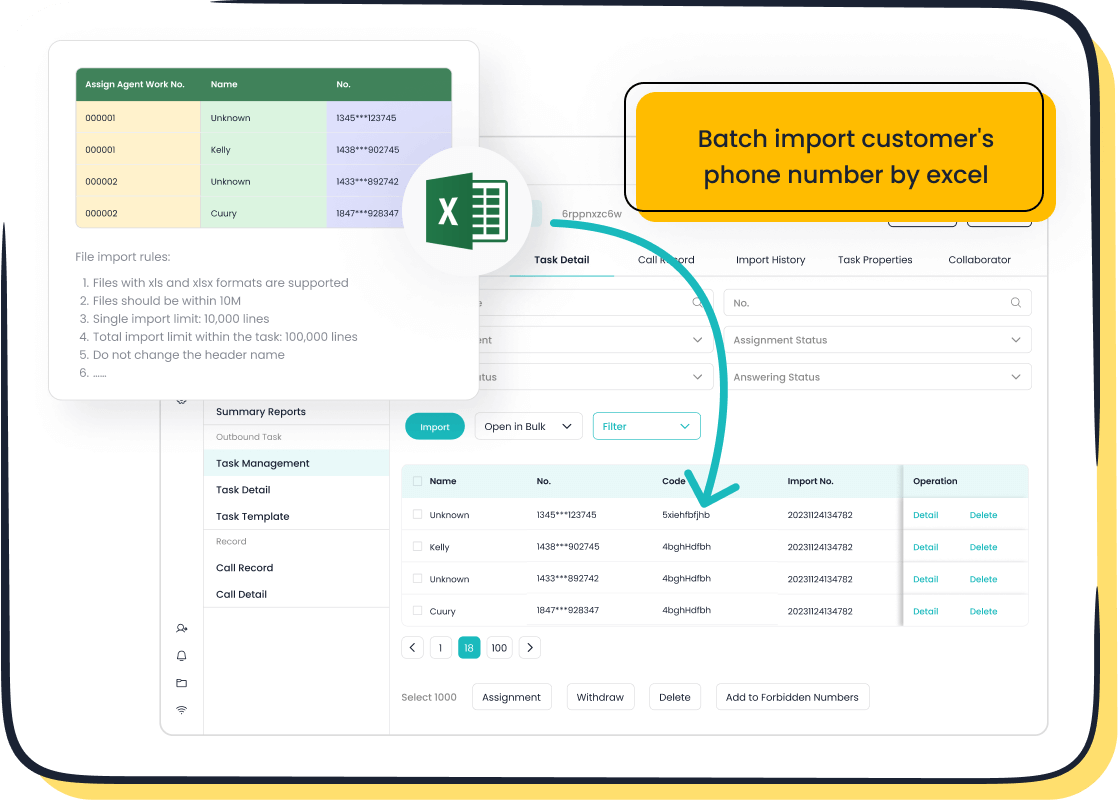
Tracking Customer Service KPIs
Support teams need clear methods to measure and interpret each kpi. Tracking metrics like time to resolution and agent response rates helps managers see where the team excels and where they need to improve. Many organizations use customer service software with centralized dashboards. These dashboards show real-time data from all support channels. Teams can:
- Set up automated responses and chatbots to handle simple questions.
- Use scripts and templates to keep replies fast and consistent.
- Categorize and prioritize tickets for urgent or complex support needs.
- Offer multichannel support, including phone, chat, and social media.
- Review kpi trends weekly or monthly to spot patterns.
- Share dashboards with all stakeholders for transparency.
- Check data accuracy with spot checks and cross-referencing.
Regular audits and clear reporting schedules help teams stay accountable and keep improving their kpi results.
Tools and Analytics
Analytics tools play a big role in measuring support performance. Sobot’s unified workspace brings together calls, chats, and tickets in one place. This makes it easy to track time to resolution, agent productivity, and customer feedback. Sobot uses AI-powered analytics to monitor key metrics like call duration, response times, and action completion rates. The table below shows some important kpi categories and what they measure:
| KPI Category | KPI Name | Description |
|---|---|---|
| Infrastructure | Number of Calls | Total calls handled |
| Execution | Assertion Accuracy | Agent completed required actions |
| User Reaction | User Interruptions | How often users interrupt the agent |
| Outcome | % Success vs % Fail | Success rate of completed support tasks |
AI tools like Sobot can reduce response times by up to 30% and improve customer satisfaction scores. Sobot’s predictive analytics also help teams forecast trends and make better decisions.
Continuous Improvement
Support teams must focus on continuous improvement to keep kpi performance high. Many use methods like PDCA (Plan-Do-Check-Act) or Kaizen to make small, steady changes. Teams gather feedback from customers and agents, then use this feedback to adjust training and processes. Proactive support strategies, such as solving problems before customers ask, also boost results. Empowering agents to share ideas and test new approaches leads to better support and higher kpi scores. Tracking progress with clear metrics, like time to resolution and feedback quality, ensures teams keep moving forward.
Companies that turn feedback into action see stronger support results and happier customers.
Using KPIs for Customer Success
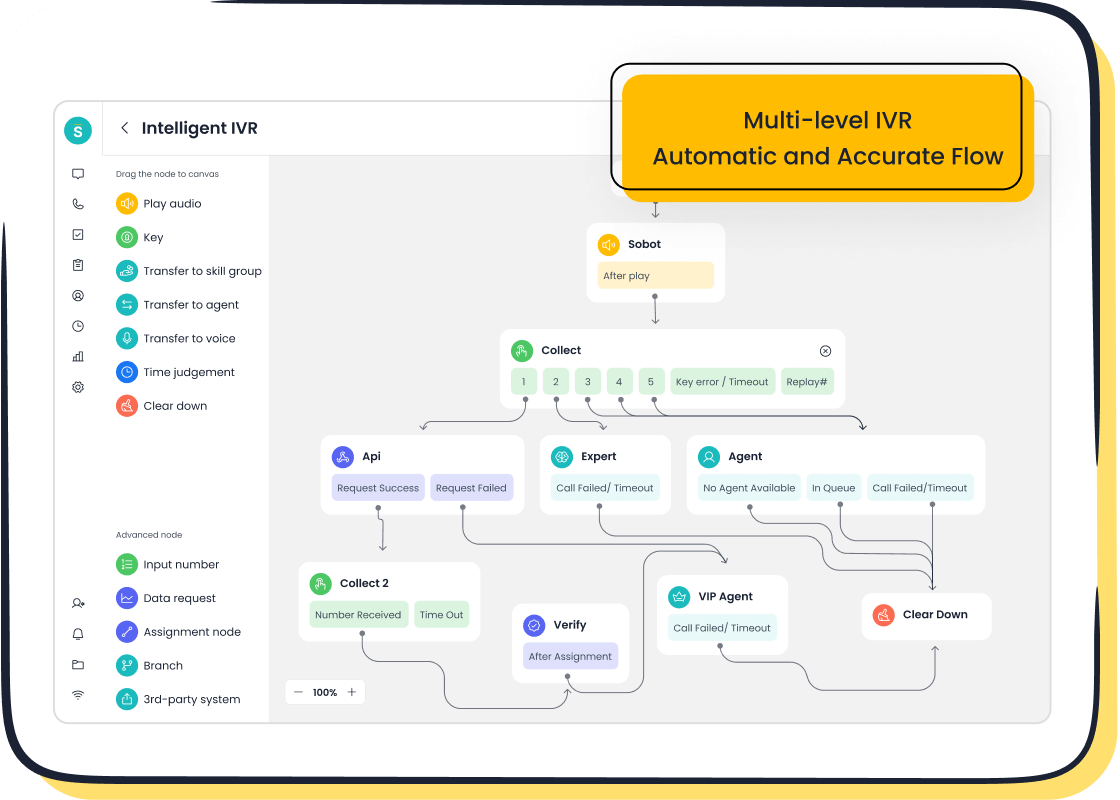
Aligning KPIs with Business Goals
Key performance indicators help companies connect their support goals to larger business objectives. Real-time dashboards show important metrics, so leaders can see trends and act quickly. This approach lets teams make decisions based on current data, which reduces risks and improves results. Companies often follow these steps:
- Set clear business goals, such as increasing the number of customers retained or improving customer retention rate.
- Choose key performance indicators that match each goal, like Net Promoter Score for customer experience.
- Assign targets for each KPI to measure progress.
- Share these targets with all teams, so everyone works toward the same outcome.
- Review and update KPIs often to keep them relevant.
- Link rewards to KPI results to motivate teams.
This structure ensures that support teams focus on the right areas. When KPIs align with business goals, companies see measurable growth and a better customer experience.
Driving Customer Loyalty
High performance in customer service key performance indicators leads to stronger customer loyalty. Metrics like Net Promoter Score and Customer Satisfaction Score show how well a company meets customer needs. A high customer retention rate means more customers return, which increases the number of customers retained. Companies with better first response times and faster resolutions create a smoother experience. This positive experience encourages repeat purchases and lowers churn. Over time, a higher customer retention rate boosts revenue and builds long-term relationships. Companies also see a rise in customer lifetime value and a drop in product returns. These results prove that focusing on customer experience and key performance indicators drives loyalty.
Sobot’s Omnichannel Advantage
Sobot’s omnichannel solution gives companies a single platform to manage every customer experience. The system connects support channels like email, chat, social media, and phone. This integration helps teams track key performance indicators across all touchpoints. Sobot provides over 300 reports and thousands of indicators, making it easy to monitor customer retention rate, number of customers retained, and overall customer experience. AI features reduce agent workload by 60%, improve conversion rates by 15%, and cut resolution time to under one minute. Net Promoter Score can rise by 35%, and ROI can increase by 234%. Sobot’s unified data and AI insights help teams respond faster and improve every customer experience.

Sobot’s omnichannel platform supports proactive outreach and quality checks, helping companies optimize key performance indicators and deliver a better customer experience every time.
Understanding and tracking customer support key performance indicators leads to better customer loyalty and higher profits. Research shows that measuring metrics like CSAT and first contact resolution helps teams spot issues early and improve service. Sobot’s solutions make it easy to monitor these customer service key performance indicators and drive results.
- Businesses can start by:
- Assessing data readiness and choosing the right tools, such as Sobot’s platform.
- Training staff and launching a pilot to track KPIs like CSAT and NPS.
- Reviewing results and scaling successful strategies.
Explore Sobot’s website or contact their team to begin your KPI journey.
FAQ
What are customer support key performance indicators?
Customer support key performance indicators measure how well a team meets goals like customer satisfaction score, first contact resolution, and time to resolution. These metrics help leaders track progress, improve support, and create a better customer experience.
How does Sobot help improve customer service KPIs?
Sobot provides real-time analytics, AI-powered chatbots, and a unified workspace. These tools help teams reduce average response time, increase first contact resolution, and boost customer satisfaction score. Companies like OPPO saw an 83% chatbot resolution rate using Sobot.
Why is customer feedback important for support teams?
Customer feedback shows how customers feel about their experience. Teams use this data to improve customer service metrics, adjust training, and fix problems. High feedback scores often lead to a higher customer retention rate and more customers retained.
What is the difference between average resolution time and time to resolution?
Average resolution time shows the typical time it takes to solve support issues. Time to resolution measures how long each case takes from start to finish. Both metrics help teams find ways to improve customer service and reduce wait times.
How can companies increase the number of customers retained?
Companies can increase the number of customers retained by improving customer service key performance indicators. Fast first response time, high customer satisfaction score, and low customer effort all help raise the customer retention rate and create a better customer experience.
See Also
Enhancing Call Center Efficiency Through Effective Monitoring Techniques
Top Strategies For Managing Quality In Call Centers
Ten Ways To Improve Customer Satisfaction In Live Chat
Comprehensive Overview Of Quality Assurance Tools For Call Centers
Understanding Quality Management System Principles For Call Centers
